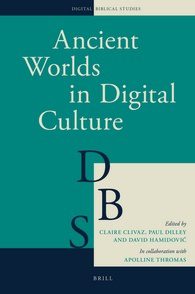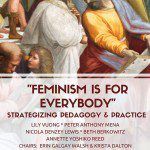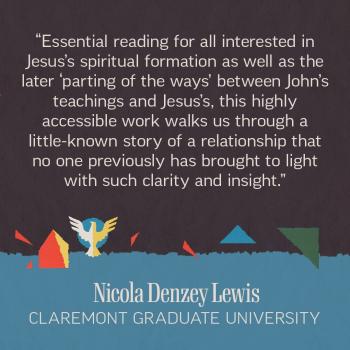Here are my thoughts on the first volume in the Digital Biblical Studies series from E. J. Brill, Ancient Worlds in Digital Culture, which I am offering in a review panel that is occurring right now in San Antonio. My own contribution focuses on chapters 1, 5, and 9-12.
 This first volume in the new Brill series, Digital Biblical Studies, launches the project in an incredibly appropriate manner, with an introduction that explores the big question – what exactly is meant by the “Digital Humanities” and what is the value thereof? The other chapters then provide snapshots of specific projects and their application – whether in terms of pedagogical value in the classroom or in terms of research conclusions, and whether in terms of accomplishments already realized or prospects for the future. The volume thus provides a useful map indicating where the Digital Humanities are, where they have come from, and where they are headed.
This first volume in the new Brill series, Digital Biblical Studies, launches the project in an incredibly appropriate manner, with an introduction that explores the big question – what exactly is meant by the “Digital Humanities” and what is the value thereof? The other chapters then provide snapshots of specific projects and their application – whether in terms of pedagogical value in the classroom or in terms of research conclusions, and whether in terms of accomplishments already realized or prospects for the future. The volume thus provides a useful map indicating where the Digital Humanities are, where they have come from, and where they are headed.
The participants in this panel apportioned the chapters among ourselves. I indicated that the whole volume was fascinating and that I really was not only willing but happy to talk about any of the chapters, and so I let others “claim” the chapters that most interested them, and while there are some others that I was particularly enthusiastic to write about just because of intersections with my own research and teaching areas, I was not in any way disappointed with the ones that remained for me to cover. It is a testament to the value of this volume that one can be given just a subset of its contents and feel not merely satisfied but enthralled, fascinated, provoked, and engaged.
David Hamidović’s introduction to the “emerging digital culture” begins on a somewhat depressing note: he describes how he continues to hear from colleagues the recommendation that he should “Be serious, leave the Digital Humanities’ groups and come back to the academic field” (p.1). Depending on what is meant by this bit of advice, it might be understandable, depressing, or simply laughable. It is certainly true that it is not and should not be the aim of those working in the Digital Humanities to huddle together and do something that, while connecting us with others exploring the uses of technology, disconnects us from the specific academic fields to which we are applying digital methods. But the comment, as reported by Hamidović, does not sound like an invitation to return to share wisdom and practical insights. It sounds, rather, like the snide (and in my opinion, thoroughly inappropriate) comments that one sometimes hears about technology from those (usually older) academics who view it with disdain, perhaps because they do not understand it or find it difficult to learn, and since they did not use it when they were students, they feel free to be dismissive and assume that they have no need of what these innovations have to offer. However, as this chapter and the volume as a whole illustrates, Digital Humanists are accomplishing impressive and exciting things, and we are doing so in relation to specific academic fields with which we continue to be associated. Older questions are being answered with the help of technology, and important new questions are, as always, being raised as such progress is made.
Nevertheless, Hamidović raises important questions about the character of the Digital Humanities, and whether we are a field in our own right, a way of working in other fields, or an interdisciplinary phenomenon that includes both and more. On the one hand, if all it took to work in the Digital Humanities were the use of digital technology, then only those without phones or e-mail would be situated beyond its boundaries, and very soon we could simply say that there are no longer any completely non-digital humanities. On the other hand, it is possible to use digital (as other) tools within a field unreflectively, without stepping back to analyze and discuss how those tools and methods change the nature of our work. Thus it can be argued that Digital Humanities in the fullest sense truly exists only where it exists reflectively. However, I would note that in other fields, those who engage in meta-level reflection on methods, rather than merely taking them for granted and applying them, do not face similar criticisms to those that digital humanists encounter, nor do they have a separate label. So what makes the Digital Humanities different? Presumably the historic tendency, on the one hand, for those in the humanities to represent a backwards-looking stance that defends “great books” (the older and the dustier the better), while on the other hand, having so much in common that it makes sense for us to not isolate ourselves into disciplinary silos, but to collaborate not only within biblical studies, but across boundaries of field and discipline.
Hamidović expresses his surprise that, despite significant disagreement about how to define the meaning of “Digital Humanities,” there are nonetheless many accounts of its history.[1] I confess that I had never traced the threads back to what are arguably their earliest beginnings, in Roberto Busa’s project to create a concordance to the works of Thomas Aquinas, which began in 1946, but started using punch cards, magnetic tape, and an IBM computer in the early 1960s. This beginning reflects an exemplary starting point for DH, given that it represents an instance of a clearly-defined humanistic research aim providing the impetus, with researchers then harnessing the best and most appropriate technological resources at their disposal to accomplish the task before them. Alas, not all DH projects have had these characteristics, and Hamidović notes the sometimes disappointing results of endeavors that either set unrealistic goals (perhaps hoping that technology would arrive as savior to make the seemingly impossible possible) or used technology unreflectively. He then goes on to outline some of the important and promising directions in DH at present, including improved scholarly communication, reflection on the implications of the shift to digital platforms, the adaptation of tools from other domains (in particular from forensics), pedagogical applications, virtual reality (not only in the fullest sense, but also in the creation of digital representations of geographic and cartographic spaces), and the economic needs and potentials of DH at a time when funding for the humanities is sometimes in jeopardy. The rest of the chapters of this book address and illustrate these issues.
Chapter 5, by David Bouvier, focuses on the metaphors that have been chosen for our digital activities, and their classical roots. We navigate the web, and the two activities – surfing and weaving – are both prominent in the Odyssey. Play with words and images looms large in the chapter, as a paper in French on “Les humanités délivrées” leads to an exploration of two possible understandings of the French word – the humanities “liberated,” and/or “de-booked.”[2] The book, Bouvier notes, has gone from denoting the contents of a work, to the container of literature, and now is moving back again to its older meaning. And so word play is appropriate – perhaps supremely appropriate – in an exploration of how words, and their containers, have changed over time, and how the one has always shaped and continues to shape the other. But more than that – and prior to and after that – the printed book represents an island of stability in an otherwise more fluid sea of words. Prior to writing, and prior to their being written down, epic stories were told and retold in diverse forms. Writing captured snapshots thereof, and fixed them for a while. But even then, we are prone to forget, for a long time bookbuyers could indicate to booksellers what contents they desired their books to have. And so even printed books had a certain degree of flexibility in the early days of print, as well as in the era of handwritten codices. Now – despite the promise of digital technology to preserve information more precisely than analog encoding, with a one or a zero, on or off, same or different – the world wide web is allowing texts not merely to flow and proliferate but to run wild and diversify again.
The use of Greek epics provides more than illustrations. It is an insightful analogy to highlight the way that the song of the sirens, offering all-encompassing knowledge, also caused forgetting, and to compare this with the way that the abundance – or better, excess – of information that flows in the present day serves not to better inform and remind, but to overwhelm and erase. The siren call of the internet offers information beyond what any one human can process. “The Sirens’ episode reveals…the necessity to format knowledge and the impossibility for Man to listen to a song that encompasses all knowledge.”[3] The chapter’s exploration of the similarities and contrasts between the economy of knowledge in ancient Greece and our current situation leads to the following striking observation: “Today, internet users not only want access to all the knowledge of all times, but they want it to be accessible everywhere and immediately. Let us remember how difficult it was, less than ten years ago, to have access to rare books when the library was closed. Now, at any moment of the day or night, one may consult practically any text of ancient literature that has come down to us. Imagine a researcher sitting in a crowded café with a Wi-Fi connection. He can consult, without getting lost in the corridors of various institutions, different manuscripts, all the catalogues, millions of titles, at present digitalized, of the biggest libraries. He can read in extenso, without having to return them to the shelves afterwards, thousands of digitized books, and their number never ceases to rise…Thanks to Wi-Fi connection, a small café nearly anywhere in the world may become the access to infinitely richer knowledge than the library of Alexandria could ever have been.”[4] For those of our colleagues who value old books above all else, and view the internet with disdain, these statements might seem blasphemous. And yet those old books are well represented online, and the question is not whether they will continue to exist, but what their place is in the overwhelming and ever-growing deluge of online information.
Chapter 9 by Todd Hanneken explores one of the tools available to digital humanists: the use of spectral RTI to decipher illegible manuscripts, including palimpsests and texts that had been burned or damaged. Damaged texts are relevant to the digital humanities in numerous ways – not only in deciphering the illegible, but in preventing damage by lessening the necessity to handle texts and artifacts in order to study them, by allowing the reassembly of fragments virtually in multiple combinations, and in other ways. Much of the chapter is dedicated to the details of precisely what Spectral Imaging and Reflectance Transformation Imaging can do. Explanation is offered of how the human eye perceives color, and why this leaves the unaided eye facing significant challenges and disadvantages when dealing with inks and manuscripts. This is an excellent survey of how these imaging methods work, challenges to their implementation such as cost and how to face and overcome those challenges, and what these tools can offer to a range of scholars working in different areas. If there is any minor complaint, it is that I would have loved to have read even more about the specific undertaking – the Jubilees Palimpsest Project – which generated the information and insights in this chapter.
David Hamidović also contributed chapter 10 to the volume, which focuses on digital solutions to an editorial challenge: the fact that a great many ancient texts that have come down to us are not simply better, worse, or even merely different copies of the same work, but represent partially-overlapping works that might not be appropriately considered “the same work” at all. Even when the order of composition and influence can be determined with a high degree of probability, modern scholars interested in historical matters are prone to focus on whichever version deemed more original, and to neglect the others. Hamidović focuses on the example of the Community Rule from the Dead Sea Scrolls, 1QS, which is one of the most famous discoveries from Qumran. Yet other texts – not only 1QSa and 1QSb, but also 4Q255-264, fragment 4 of 5Q13, and 11Q29 may be copies, variant versions, or other works that merely quote or allude to the Community Rule, or one of the other texts that overlap with it. But that they are related, and yet distinct, seems clear. Traditional editing approaches would generally focus on the most complete text, with other shorter evidence provided in parallel columns, or in a footnote, or in some other manner. 1QS has had the “advantage” of being among the earliest of the Qumran discoveries, and among the earliest to be published, and these factors may therefore also have influenced assumptions about its priority.[5] Hamidović wants to move away from terminology – such as “variants” and “versions” – that assume that one work is merely an inferior derivative of the other. Those who work in Biblical studies ought to be aware of this – extensive use of Mark by Matthew and Luke, or extensive use of the Deuteronomistic History by the Chronicler – does not make the later works unimportant or uninteresting. Indeed, in some ways this relationship allows us to say more, with a higher degree of certainty, about the later works and their historical situation.
Where printed editions had no choice but to either prioritize one manuscript, or create an eclectic edition from many, or print works in parallel columns that did not facilitate the reading of any of them, modern technology allows us to interact with a multitude of texts dynamically. Hamidović envisages (or better, dreams of and hopes for) a platform that does more than merely hyperlink between manuscripts or transcriptions in what is still a linear fashion. A platform that integrates and provides relatively seamless access to photos of the manuscripts, facsimiles with restorations, and transcriptions, would allow one to not merely read the text, but work with the originals to evaluate aspects such as hypothetical restorations in lacunas, or the piecing together of fragments. The platform should also have three additional aspects: tagged words, translation, and comparison of translations across scrolls.[6] And so if chapter 9 focused on how existing technology was not only used but supplemented, and new technology was developed, in order to read words that had been erased from an ancient manuscript, chapter 10 illustrates an earlier stage in the process that also leads to new innovations: the identification of needs, and contemplation of not just how existing technologies and platforms might help address those needs, but daring to envisage new interfaces that would do what existing ones might not.
Chapter 11 by Sara Schulthess explores the way in which the digitization of texts, and online discussion of scholarship, brings our work into contact with debates and discussions in the popular realm, often undertaken in a manner that differs both in its approach and its aims from what scholars seek to do in the context of mainstream universities. Textual criticism was, for a very long time, an area that New Testament scholars appreciated and built upon, but few of us engaged in personally. With the proliferation of digital images online, more scholars have been attracted to work in this specific area directly, and a greater number of New Testament scholars are taking interest in the physical characteristics and other details of manuscripts that we previously only knew as abbreviations in a Nestle-Aland critical edition. But now, online discussion of New Testament textual criticism can be found taking place vigorously in online discussions by Muslim apologists, who point to the evidence – including by annotating facsimiles of manuscripts made available online by universities and scholarly DH projects – in order to make the case that Christian scriptures have been corrupted, in contrast with the purportedly pure Qur’an. Schulthess presents evidence that this is not merely a case of Muslims latching onto Biblical scholarship, but of the concept of taḥrīf – “alteration or falsification” – being adjusted relatively recently in history, in response to an awareness of the diversity of Biblical manuscripts. Originally, the concept of taḥrīf appears to have had to do with the alteration of the meaning of texts, rather than the rewriting thereof, and Muslims were generally inclined to cite the Bible positively in their arguments. This changed in the 11th century starting with Ibn Ḥazm, who turned attention from meaning to the texts themselves. His focus, however, was on differences between the canonical Gospels, rather than differences between manuscripts of individual works. Thereafter, in the 19th century, developments in textual criticism were noticed and interacted with in the Muslim world, leading eventually to the situation we encounter today.
Here we see some of the exciting challenges and opportunities, and worrying pitfalls, of scholarship in the digital era. To what extent should scholars be worried about the use of their work by religious apologists? Should we write, and make materials available, in ways that seek to preemptively address such matters? Or is that not our purview? Ought a New Testament text critic to accept an invite to speak on an Islamic internet podcast? Must textual critics today feel obligated to familiarize themselves – as Schulthess clearly has – with a range of religious texts and ideas that lie well outside the historic, narrowly-defined domain of NT text criticism? As the historical overview provided in this chapter makes clear, it is not as though interaction with text criticism by Muslim apologists – or King James Onlyists or anyone else, for that matter – is something that begins in the era of the digital humanities. But the internet is changing the dynamics of the interaction, as more and more scholarship is online, and thus available to not only be used by those who wish to inform themselves, but also open to distortion by those who wish to make ideological arguments. This happens not only in relation to textual criticism or even the humanities, but in the natural sciences, as scientists’ words are taken out of context by science-deniers of various stripes. And so the internet era raises the question of what our duty is as digital humanists and as scholars more generally. Is it enough to put materials online to make our own work easier, or must we consider the implications of our doing so for a wider audience, one whose aims and interests we may not be familiar with, and which may differ from our own?
The final chapter in the book is by Apolline Thromas, and it focuses on rabbinic literature, and the way the proliferation of some works (with slight differences between them) in the era of copying by hand, prior to the use of the printing press, mirrors the current situation, with the proliferation of different websites with different editions and different formatting of the same basic underlying works. In contrast with the conventions that have become at least somewhat standardized in Biblical studies, the ways or referring to and abbreviating the names of rabbinic texts is confusingly diverse, making it hard at times to even find all the relevant web resources. The fact that some famous and influential early printed editions of rabbinic works were not based on the best manuscripts mirrors the situation today as well, when the best manuscripts may be behind paywalls or in expensive print volumes, and so most would-be readers will turn to older versions which are in the public domain, and thus can be found online for free. And so here too the ethics of the digital humanities comes into the picture. The previous chapter highlighted risks of making information publicly available without cost; this one highlights the risks of not doing so. Thromas notes that most websites do not allow for comparison of different manuscript witnesses of the works in question, and she thus highlights the Digital Mishnah Project as a praiseworthy exception. By way of contrast, Thromas points to the Torat ha-Tannaim on the website of Bar Ilan University which, if one visits it, announces that they are very sorry, but it can only be viewed with Internet Explorer 5.5![7] As we emphasize making primary sources and scholarly products available online for free, we cannot ignore that there is a cost involved in creating platforms, hosting materials, and keeping them up to date.
In concluding, let me point out that we have seen several key themes running through even the subset of chapters that I focused on. One is the democratization of knowledge. Laypeople can interact with scholarship to a greater extent in our time, sometimes making a useful contribution themselves, while at others seeming to distract from or misconstrue the online materials. But to some extent digitization also “democratizes” or levels the playing field between texts as well. While texts that have historically been of greater interest to a larger number of people may still be found on a greater number of websites, merely by virtue of being included and listed in the table of contents of web repositories, minor midrashim or smaller and more fragmentary Dead Sea Scrolls may get long-overdue attention.
Another major theme is the intersection of scholars with a broader readership and the wider internet. I think that this aspect of the Digital Humanities is what most concerns some of our detractors. And in one sense, it is hard to blame them. One has only to read a few YouTube comments to begin to doubt not just the educational value of YouTube, but the humanity and humaneness of those encountered there. But that is not fundamentally different from earlier verbal, then handwritten, then print sources, except for the fact that digital online comments cost nothing, and so a broader array of people will leave a blog or Facebook comment than would have made the substantial effort in a bygone era, and typed or handwritten a letter and paid for a stamp to send a letter to the editor in order to have some slim hope that their response to an academic’s article might appear where others could get to read it. But getting to hear from more people cannot be a bad thing, in and of itself. And to the extent that not only professional researchers but our students must navigate the dangerous currents that we surf upon online, we as professors are the ones who must provide the training and guidance needed.
And so if there is any criticism of the volume I could make, it is a fairly minor one: I would have liked to see more explicit engagement with the subject of information fluency. The topic was right beneath the surface frequently: Are religious apologists trustworthy sources? Are scholars and apologists always distinct categories or do they sometimes overlap? Should interested laypeople turn to popularizing sources that may misrepresent or at least lose the nuance that scholarly sources strive for, or must they turn directly to what may be cumbersome, obscure, lengthy, and unnecessarily technical scholarly writing? Can we train students by taking them back to the raw data so that they cease to merely be users of maps of Paul’s travels produced by others, and instead become contributors to the knowledge that is available? Even our undergraduate students often know more about some topics than the average Wikipedia editor does. And so should we not be requiring our students to not merely avoid or critically engage with Wikis but to improve them? These are important questions, and I fully recognize that it may not have been feasible to incorporate them into this volume. And so this is less a criticism, and more a plea that some future volume in the series might turn its attention to this crucial subject.
As you can see, even when it comes to areas that were implicit rather than an explicit focus, the first volume of the Digital Biblical Studies series offered food for thought that led me not merely to be encouraged in what I already do, but to think about and discover new ways of doing things, and to learn how to do new things that I hadn’t previously considered. It encourages readers to imagine what technology cannot yet do and how it might be developed to help us better understand the past, and through that, ourselves. And so I wish to conclude by saying that this volume is not merely a sufficient, but an overwhelmingly persuasive answer to those detractors that David Hamidović mentioned in his opening chapter. Anyone who can read this volume and not appreciate the value of the Digital Humanities is, in my opinion, not a detractor with respect only to the “Digital Humanities,” but to the humanities themselves, because the benefits and fruits of the methods and tools being harnessed is abundantly clear.
[1] p.3
[2] pp.87-88.
[3] p.96
[4] pp.103-4.
[5] p.200
[6] pp.208-9.
[7] p.243.













